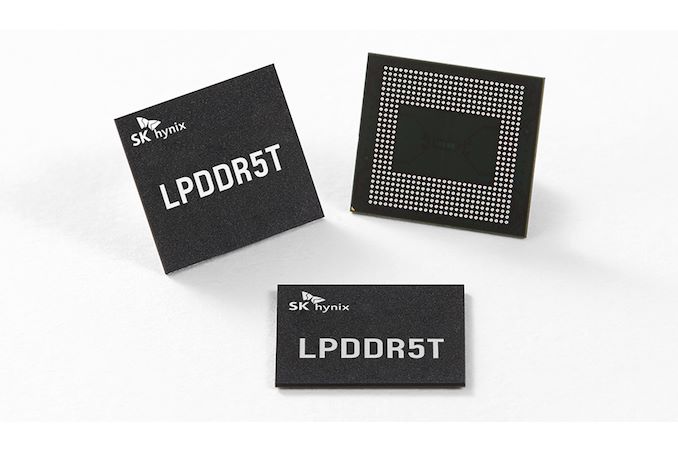Micron and SK hynix Ship LPDDR5-9600 Memory for Next-Gen Smartphones
by Anton Shilov on October 25, 2023 9:30 AM EST
Fast memory is crucial for the performance of high-end system-on-chips that are getting more sophisticated every year. When it comes to smartphones, the most obvious way to boost memory performance is to push its data transfer rate. Apparently, this is what Micron and SK Hynix are doing with their new LPDDR5X and LPDDR5T DRAMs that boast a data transfer rate of 9.6 GT/s.
Micron's LPDDR5X-9600 memory devices are made on the company's latest 1β (1-beta) process technology. They are offered in up to 16 GB x64 packages (though it is unclear how many actual memory devices these packages integrate). Micron says that its LPDDR5X made on its latest production node boasts up to 30% lower power consumption compared to competing LPDDR5X ICs made on 1α (1-alpha) technology, though this is something to be expected.
Micron does not disclose how it managed to increase the data transfer rate of its LPDDR5X to 9.6 GT/s, which is a 12% increase compared to 8.53 GT/s, which was once considered the highest speed of LPDDR5X memory. The only thing that the company discloses is that these ICs boast 'enhanced' dynamic voltage and frequency scaling, although DVFS is a part of LPDDR5X specification.
"Generative AI is poised to unleash unprecedented productivity, ease of use, and personalization for smartphone users by delivering the power of large language models to flagship mobile phones," said Mark Montierth, corporate vice president and general manager of Micron's Mobile Business Unit. "Micron's 1β LPDDR5X combined with Qualcomm Technologies' AI-optimized Snapdragon 8 Gen 3 Mobile Platform empowers smartphone manufacturers with the next-generation performance and power efficiency essential to enabling revolutionary AI technology at the edge."
SK Hynix is another company to start shipping LPDDR5-9600 memory today, which calls its fastest LPDDR5 DRAMs LPDDR5T (T stands for Turbo). The new memory will be available in 16 GB packages with a VDD voltage range of 1.01V to 1.12V and a VDDQ of 0.5v. By contrast, LPDDR5X should have a maximum VDD voltage of 1.1V, so LPDDR5T is slightly out of LPDDR5X spec.
Meanwhile, both Micron's LPDDR5X-9600 and SK Hynix's LPDDR5T-9600 are compatible with Qualcomm's Snapdragon 8 Gen 3 system-on-chip for smartphones, the two compares announced on Tuesday. Micron is already shipping its 16 GB LPDDR 9.6 GT/s modules featuring a 76.8 GB/s peak bandwidth, so expect some of Qualcomm's partners to use the world's fastest mobile memory shortly. SK Hynix's module has been validated by Qualcomm, so the South Korean company will likely begin commercial shipments of its LPDDR5T-9600 product soon.
"We are thrilled that we have met our customers' needs for the ultra-high performance mobile DRAM with the provision of the LPDDR5T," said Sungsoo Ryu, head of DRAM Product Planning at SK Hynix.










23 Comments
View All Comments
Kevin G - Tuesday, October 31, 2023 - link
Indeed. Upon boot the OS consumes nearly half of that 8 GB figure which leave 4 GB for applications. That should be plenty for basic tasks but abominations like MS Teams can consume 5 GB on their own (I personally seen this. It was repeatable for awhile.). At this point things are hitting the slow swap file and performance crashes.8 GB can be useful today but it’d require software developers to get their act together and rewrite code to be lean and efficient again. Inefficient but works is what they’ll produces until consumer outrage becomes too much or vendors just make 16 GB standard.
ballsystemlord - Thursday, October 26, 2023 - link
Although RAM BW hasn't been able to keep up with compute performance, that doesn't mean that soldering DRAM down will alleviate the problem. If anything, we could try and have more channels if we want more BW from our RAM.If we tried the soldered down approach, then MBs would have to be much bigger and the manufacturers of MBs would have to produce many more models leading to a huge increase in cost. What's more, when your RAM goes bad, you'd have to replace the whole MB.
So personally, I'll stick to socketed RAM.
brucethemoose - Thursday, October 26, 2023 - link
More channels also means much more cost.The RAM could be packaged on the CPU like Apple's M series, and the CPU could still be socketed. This would *decrease* the cost of the motherboard too, as it no longer has to run all those RAM traces.
TheinsanegamerN - Monday, October 30, 2023 - link
Exactly. Keep CAMM around, we dont want everything soldered and disposable.Doug_S - Wednesday, October 25, 2023 - link
You're sacrificing latency for low power and bandwidth by using LPDDR5 instead of DIMMs.Samus - Wednesday, October 25, 2023 - link
With the size of modern CPU caches, RAM latency is becoming less and less important.ian9298 - Wednesday, October 25, 2023 - link
Exactly, so why bother?The more caches you have the less relevant memory performance is so the cheaper, expendable, replaceable DIMMs is a no brainer.
brucethemoose - Thursday, October 26, 2023 - link
And as for bandwith, some workloads (like llama.cpp CPU offloading) are essentially RAM speed bound. I would *love* for my 7800 to be quad channel instead of dual.brucethemoose - Thursday, October 26, 2023 - link
This is not always true. I have a 7800X3D, and I got a noticable bump in some sim games running CS30 vs the default CS48.brucethemoose - Thursday, October 26, 2023 - link
Are their timings that bad? I don't see why that has to be the case when the traces are shorter and better.Surely they can be factory overclocked a bit for desktop CPUs.